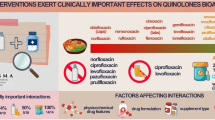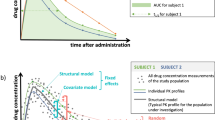Abstract
The estimation of bioequivalency using metabolite data was investigated for immediate release formulations with drugs exhibiting linear pharmacokinetics and no first-pass effect. This was accomplished by generating parent drug and metabolite plasma level profiles assuming formation and excretion rate-limited pharmacokinetic models with absorption rate constants obtained from bivariate normal distributions and designated random errors. Simulation results indicated that bioequivalence determination using C maxof parent drug and metabolite was independent of the metabolite models as evaluated by confidence interval approach. However, a clear difference with respect to the outcome of bioequivalence evaluation arises depending upon the utilization of C max values for the parent drug and metabolite. The major reason for this disparity was attributed to the minimal effect of the absorption process for the parent drug on the formation of the metabolite. This phenomenon results in an apparent lower intrasubject variability for C max of the metabolite and, in turn, a tighter confidence interval for C max of the metabolite in comparison with the parent drug. The simulated results have been found to be in agreement with the bioequivalency data for acetohexamide, allopurinol, procainamide, and sulindac. In all cases, the interval of the 90% confidence limit for C max of the metabolite is always smaller than that of the parent drug, regardless of the drug pharmacokinetics and the level of error contained in the data.
Similar content being viewed by others
REFERENCES
S. L. Nightingale and J. C. Morrison. JAMA 258 (9):1200–1204 (1987).
S. C. Olson, M. A. Eldon, R. D. Toothaker, J. J. Ferry, and W. A. Colburn. J. Clin. Pharmacol. 27:342–345 (1987).
Code of Federal Regulations, Title 21, Part 320, Office of the Federal Register, National Archives and Records Administration, Washington, D.C. 20408.
A. J. Cummings and B. K. Martin. Nature 200:1296–1297 (1963).
D. E. Drayer. Clin. Pharmacokin. 1:426–443 (1976).
J. B. Houston. Pharm. Ther. 15:521–552 (1982).
D. E. Drayer. Drugs 24:519–542 (1982).
S. Pond and T. Tozer. Clin. Pharmacokin. 9:1–25 (1984).
M. V. St-Pierre, X. Xu, and S. Pang. J. Pharmacokin. Biopharm. 16:493–527 (1988).
Pharmaceutical Manufacturers Association (PMA). Drug Metabolism Subsection Workshop on “Pharmacokinetics of Drug Metabolites,” Bethesda, Maryland, Apr. 27–28, 1989.
R. C. Boston, P. C. Greif, and M. Berman. Comp. Prog. Biomed. 13:111–119 (1981).
J. J. Lima, D. R. Conti, A. L. Goldfarb, W. J. Tilstone, L. H. Golden, and W. J. Jusko. J. Pharmacokin. Biopharm. 7:69–85 (1979).
T. M. Ludden and M. H. Crawford. Clin. Pharmacol. Ther. 31 (3):343–349 (1982).
A. J. Jackson. Biopharm. Drug Disp. 8:483–496 (1987).
M. Gibaldi and D. Perrier. Pharmacokinetics, 2nd ed., Marcel Dekker, New York, 1982.
G. Raghow and M. C. Meyer. J. Pharm. Sci. 70:1166–1168 (1981).
W. G. Kramer and S. Feldman. J. Chromatogr. Biomed. Appl. 162:94–97 (1979).
C. Lai, B. L. Kamath, Z. M. Look, and A. Yacobi. J. Pharm. Sci. 69 (8):982–984 (1980).
L. J. Dusci and L. P. Hackett. J. Chromatogr. 171:490–493 (1979).
SAS Institute. SASISTAT User's Guide, Release 6.03 ed., SAS Institute Inc., Cary, N.C.
D. J. Schuirmann. J. Pharmacokin. Biopharm. 15:657–680 (1987).
Author information
Authors and Affiliations
Rights and permissions
About this article
Cite this article
Chen, ML., Jackson, A.J. The Role of Metabolites in Bioequivalency Assessment. I. Linear Pharmacokinetics without First-Pass Effect. Pharm Res 8, 25–32 (1991). https://doi.org/10.1023/A:1015865920043
Issue Date:
DOI: https://doi.org/10.1023/A:1015865920043




